Note ** denotes a direct relative of mine in this text
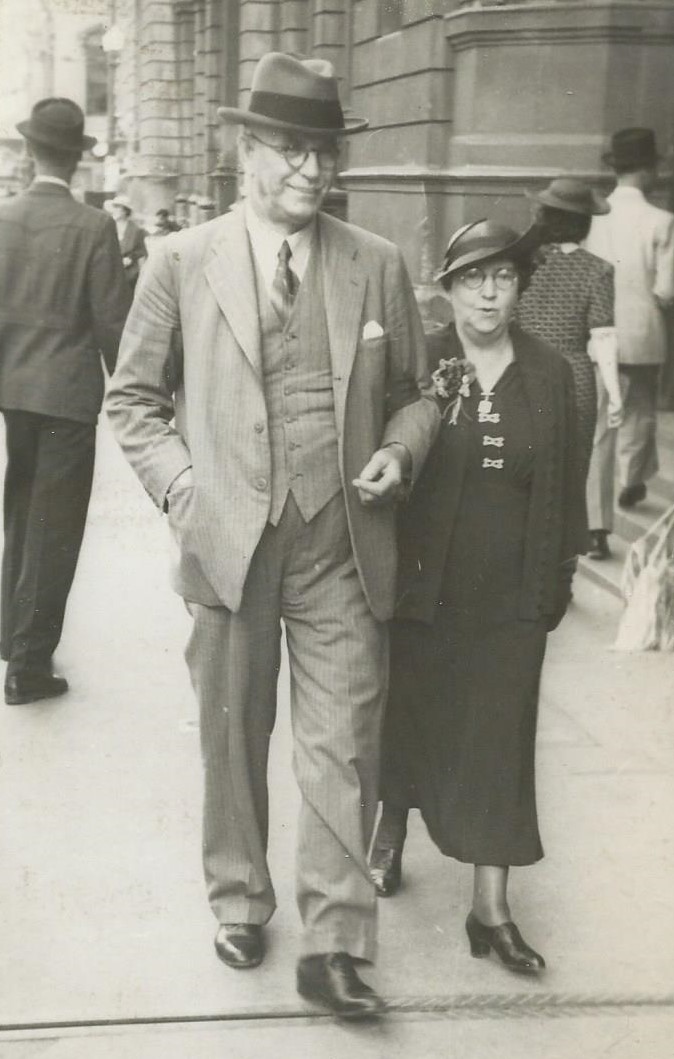
Recently my mother gave me the family sea chest, a family heirloom that had been passed down the generations. It was probably owned originally by my great-great-great-great-grandfather and shipwright, **Edward Cusens (1791 – 1861). He was the father of George Adolphus Cusens, (see **Mary Ann Stears (1820 – 1903) and **George Adolphus Cusens (1819 – 1911). Sea chests were an integral part of life for every sailor or ship’s captain, and were used for storing personal belongings during long voyages. Their contents brought solace in a time when travelling by sea was particularly perilous. Clothes, documents, pictures of loved ones and patron saints along with rosaries and prayer books could be found in them. The Sailor’s Sea Chest (emz.hr)

My mother got the sea chest from my aunt Winsome Barker (my grandfather’s sister) and she gave it to me because I was the one that showed an interest in my heritage and started this website. In this sea chest my great aunt kept old family documents and her family tree which she worked on with constant input from my English relatives Bessie and Nancie McDougall, (see **Osmond Barker (1852-1935) and **Elizabeth Robinson (1855-). My mother also added documents over the years, as I also have done for my children. Now the chest is full of historical family gems. I have not yet had a chance to go through it all, but recently I discovered a letter in it written to Mr. Neville Adlam of the Star newspaper’s editorial department by my grandfather **William Edward Barker, where he describes his father William Joseph Barker. The letter below tells William senior’s story better than I can.
When discussing William Joseph Barker with my mother Denise Clur (nee Barker), she told me that he came to South Africa after his fiancée Miss Armstrong had died of tuberculosis. She thought William Joseph Barker may have had TB as well. She remembers picking poppies in her grandfather’s garden.
37 Alfred Road
Port Alfred, 6170.
17 June, 1976 ...
Dear Mr Adlam,
I was very pleased to receive your letter of June 4, 1976. Our family and I will be very pleased and honoured if you publish my father's letter about the Battle of Jamestown, in your special supplement of the Boer War and in a book based on new Anglo-Boer War documents.
I must point out, that my father's letter has previously appeared in print viz. in the booklet about the centenary of Jamestown. This book is:- JAMESTOWN: 1874-1974, Saamgestel deur ELLA WAGENAAR M.A. and Printed at the DAILY REPRESENTATIVE QUEENSTOWN,7808.
I know Miss Wagenaar very well indeed. She is on the staff of the Graeme College Boy's High School, GRAHAMSTOWN. She was born and bred in Jamestown and has been teaching at Graeme College as senior Afrikaans Teacher for over 10 years.
She assures me that there is NO question of copyright and if you wish her to supply you with any other information she will be pleased to do so. Her information for her book was gathered from the Kidwell Letters in the Cory Library Rhodes University, and from books by A. J. Kidwell (now in the possession of two grand-daughters, Mrs M, NOEL and Miss F. von Hirschberg) plus information from very old inhabitants of Jamestown.
Biographical Information of W. J. BARKER (MY FATHER) William Joseph Barker. Born on 31 July 1875 in Seaham. Co. Durham, England. He was the eldest child of Osmond Barker, a coal miner in the Seaham Colliery. Was educated at Bede College Durham (named after the Venerable Bede) and trained as a teacher. Due to ill health he came to South Africa in 1898 and obtained a post on the staff of the Bensonvale Native Training School for teachers in the Herschel District. While there he met Miss Beatrice E.J. CUSENS and married her on 7 April, 1903. In the meantime he had become the Principal of the Jamestown Public School. When he arrived it was only a Primary School, but when he left Jamestown at the end of 1918 it was a High School and in addition he was also training Pupil Teachers.
Their 4 children were all born in Jamestown and in spite of a lively family he succeeded in obtaining a B.A degree by correspondence through the University of South Africa. No mean achievement in isolated little Jamestown - where no one had a degree to help him.
He was a great reader and had a wonderful, large library, which today would be worth thousands, but alas -due to his nomadic life from 1923 onwards- the collection was sold for a song. He taught himself many things from books, from swimming to driving a car. There were only two cars in Jamestown in 1915 and he taught a friend of his to drive the new Buick he had bought. From books he became an expert Contract Bridge player (CU1bertson). He introduced Contract Bridge to the Transkei from 1923 onwards. At this time Contract Bridge was not played on much of a scale in Cape Town and other large cities. He was also a keen gardener and only the best SUTTON Seeds from England would do, both for flowers and vegetables.
In 1918 he decided that it was time to widen the horizon for his children and he obtained an appointment as Senior History Master on the staff of Selborne College, East London, where he taught very successfully until 1923. He was then appointed Inspector of Schools in the Transkei and worked in the Mount Frere, Mount Fletcher, Tsomo, Tsolo, Qumbu and Nqamakwe districts until he retired in 1935. He settled in Cape Town until 1940 when he was asked to relieve Mr. J. Mac Quarrie as Principal of the Lovedale Training College until Mr. Mac Quarrie returned from the war. After short periods with his daughter Winsome (who was the curator of the Crompton Herbarium -Kirstenbosch) and his son William in Peddie, he died while living with his son Merlin (Legal adviser to the Natal Provincial Administration) in Pietermaritzburg on 28 May, 1948.
I have no photograph of him except the small enclosed print. This was taken in front of the Naqmakawe European Primary School. My father is in the dark suit wearing a hat. the man with the hat is Dr. Viljoen, Superintendent of education of the Cape Province.
Referring to Miss Wagenaar's book there is a photo on p.58 of the Jamestown Town Guard- my father is in the first row standing. He was wearing a white collar and a white band round his hat(Cheesecutter). The man next to him is Mr. A. J. Kidwell. My Dad's letter appears on page 63. The Koppie mentioned appears an page 71 of Miss Wagenaar's book and also a photo of some of the Rebels tried by Mr. Kidwell. I think that you will find chapter LX gives a good account of the attitude of the Boer population of the Jamestown district during the Anglo-Boer War.
I followed my father as a teacher, principal and Inspector of Schools. The only case in the Cape of father and son being so promoted. He started in Mount Frere in 1923 and I there in 1949.
My daughter took a B.Sc. degree at Rhodes in Physics and Mathematics and then turned to painting and writing. Her article in CONTRAST: SOUTH AFRICAN QUATERLY: DECEMBER 1974 Volume 9 No.3, The Yellow Hula Hoop is quite interesting. So she followed her Grandfather's bent for writing. My father wrote home to his people in Seaham every WEEK for 45 years and they had a chest of drawers full of letters. After my father died in 1948 the family burnt all his letters, except the account of the Battle of Jamestown. One of my father's sisters gave me this letter when I visited Seaham for the first and only time in 1959.
The Mr. G. B. Gatt mentioned in my father's letter came from Sunderland. Now Sunderland is only 8 miles from Seaham. So county Durham supplied little Jamestown with two headmasters for the school, who were both present at the Battle of Jamestown.
If I can supply you with any further information, I shall be only too pleased to do so.
Yours sincerely, William Edward Barker"

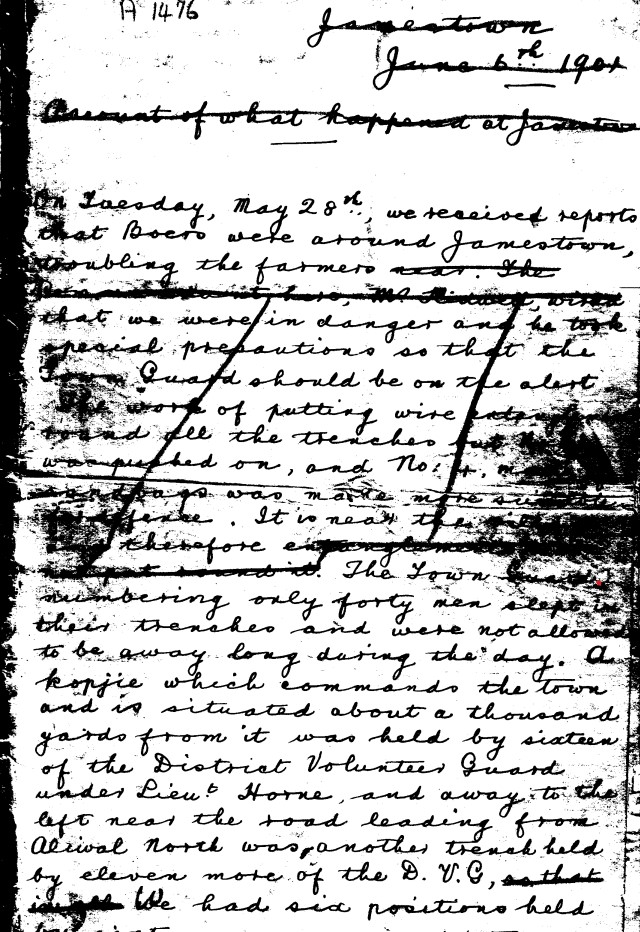
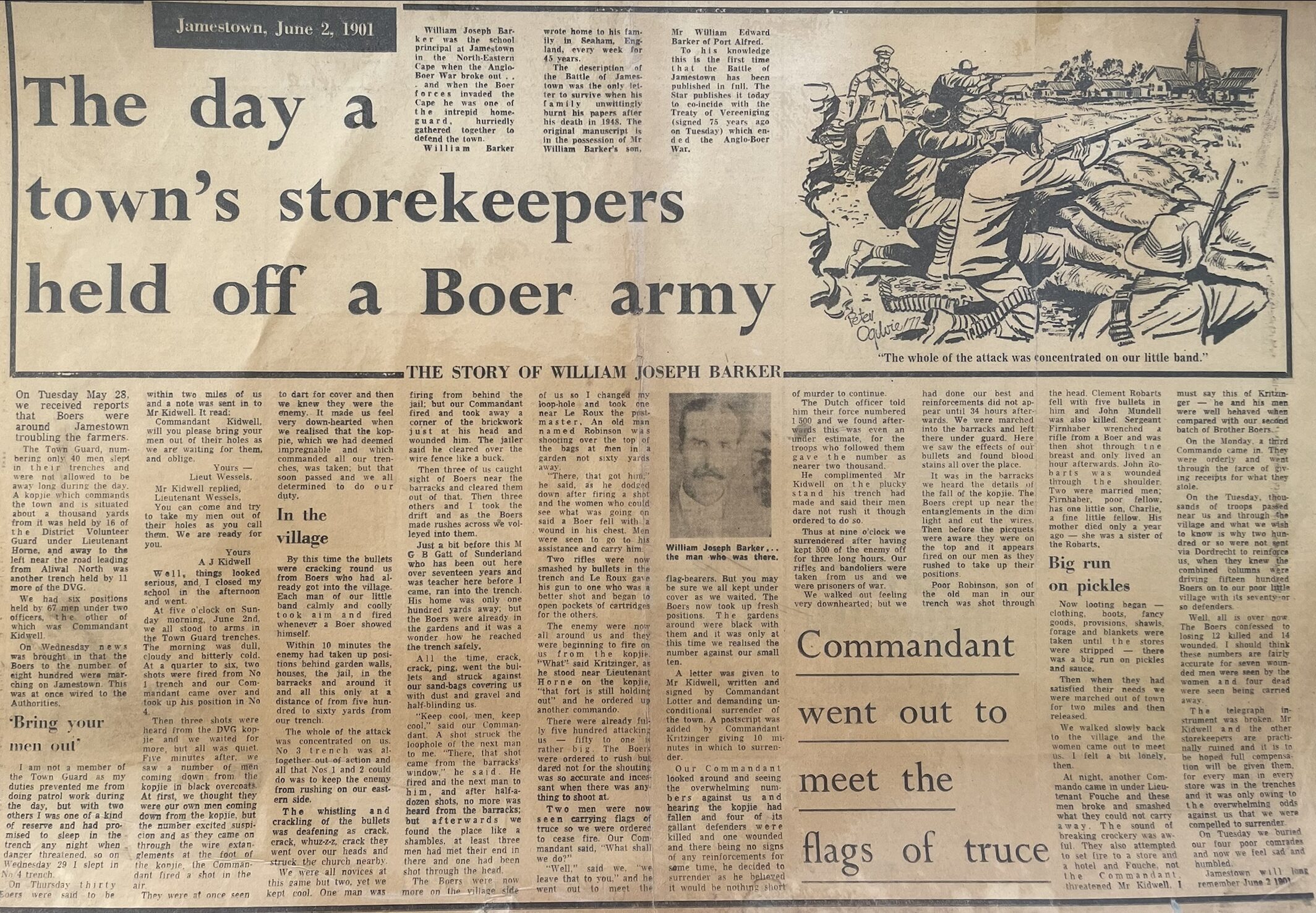
The Jamestown letter as published in The Star on Saturday 24/5/1977. This followed the letter above written by my grandfather. The letter has also been subsequently published in New Contrast 166 South African Literary Journal, Volume 42, No 2, Edited by Michael King.





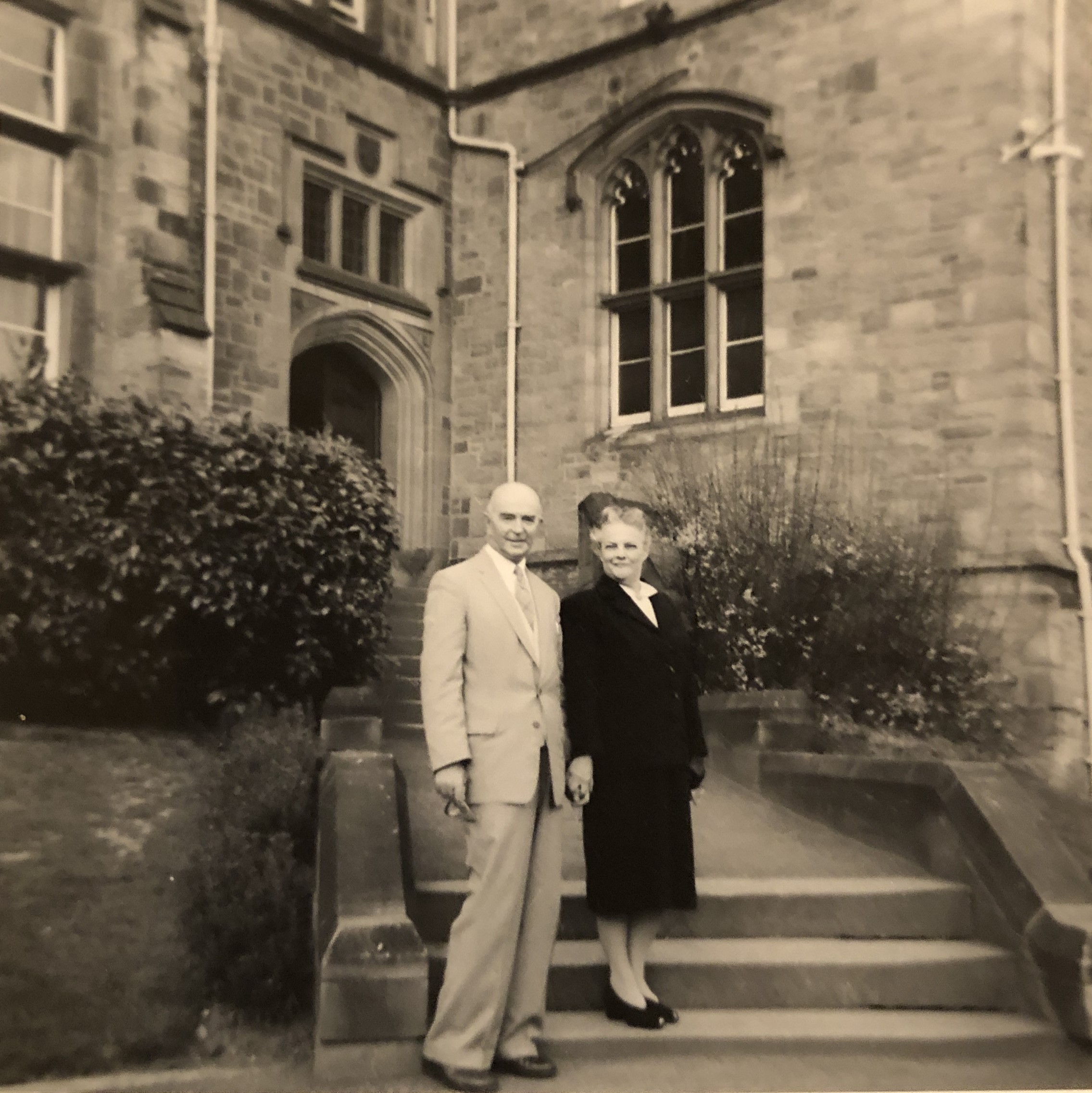
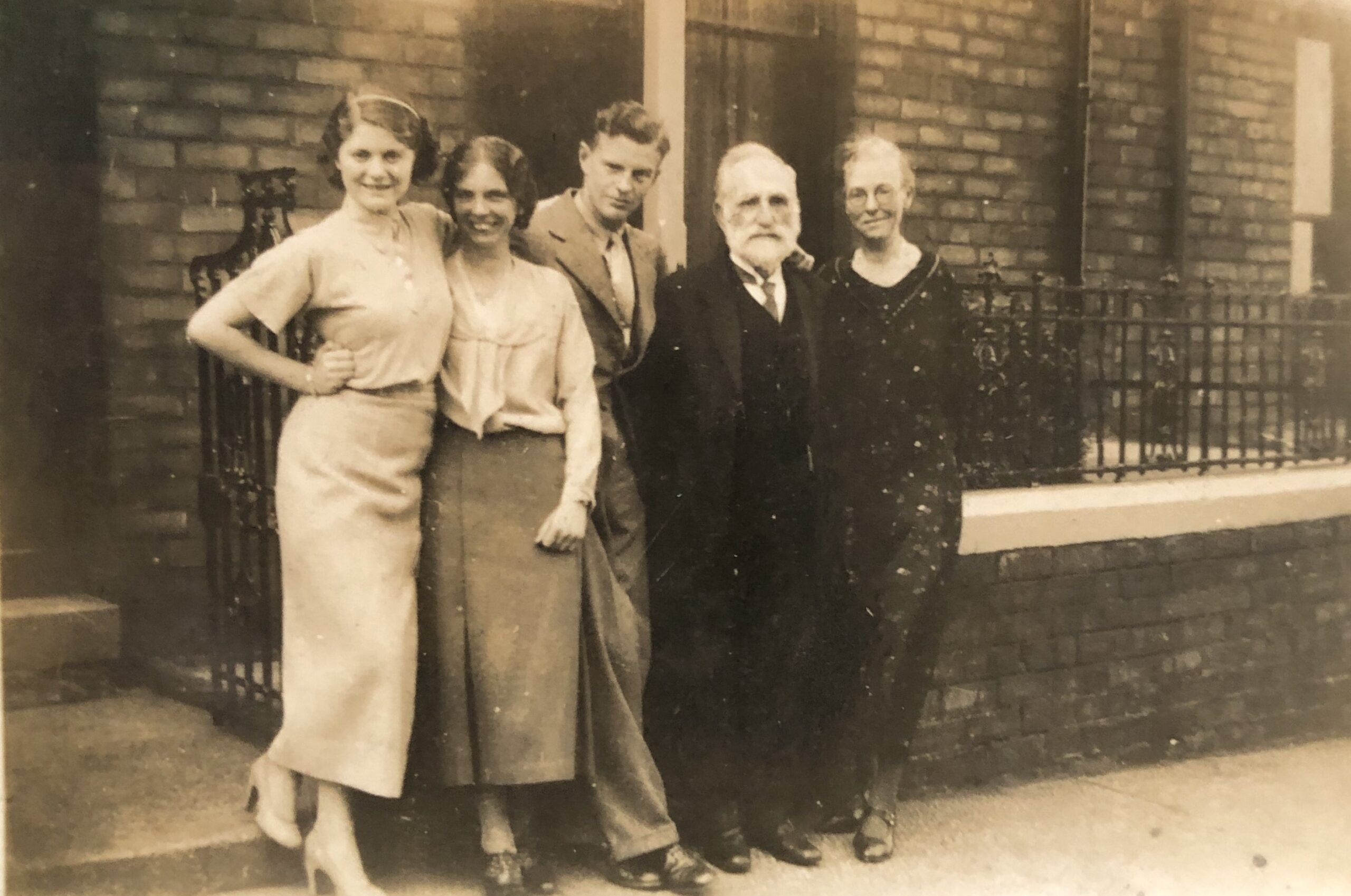
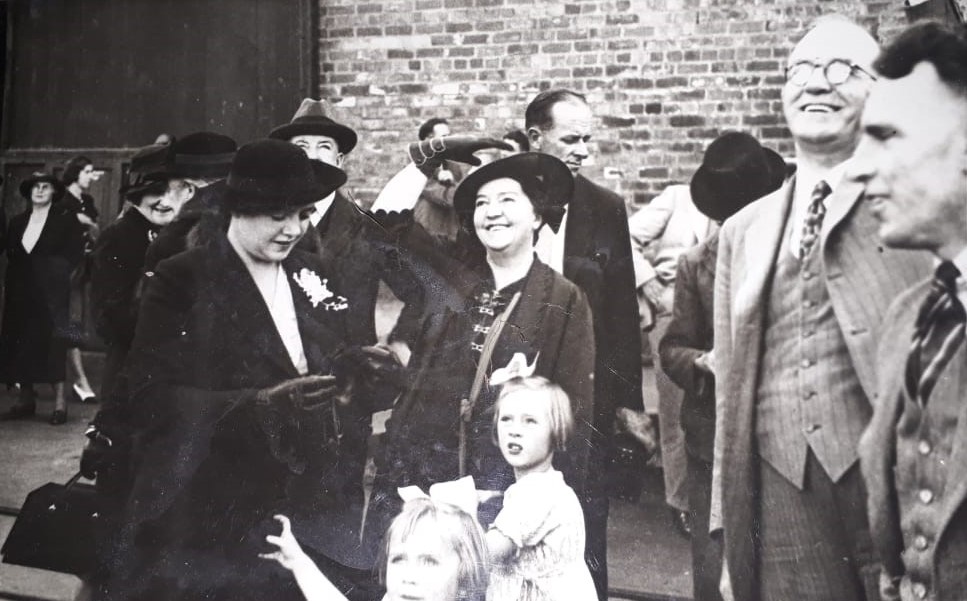

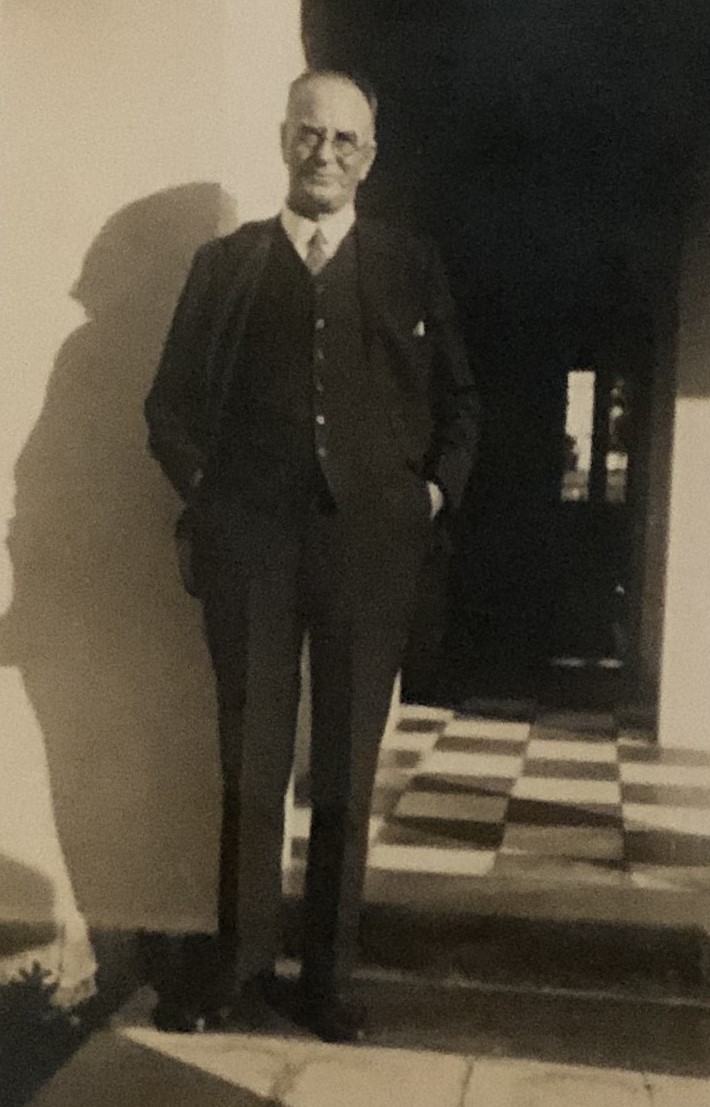
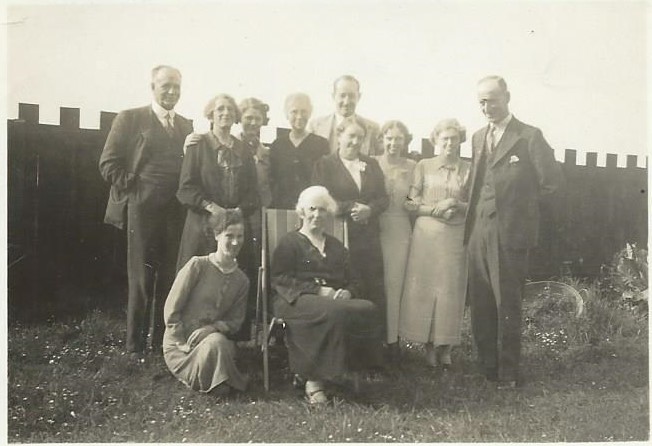
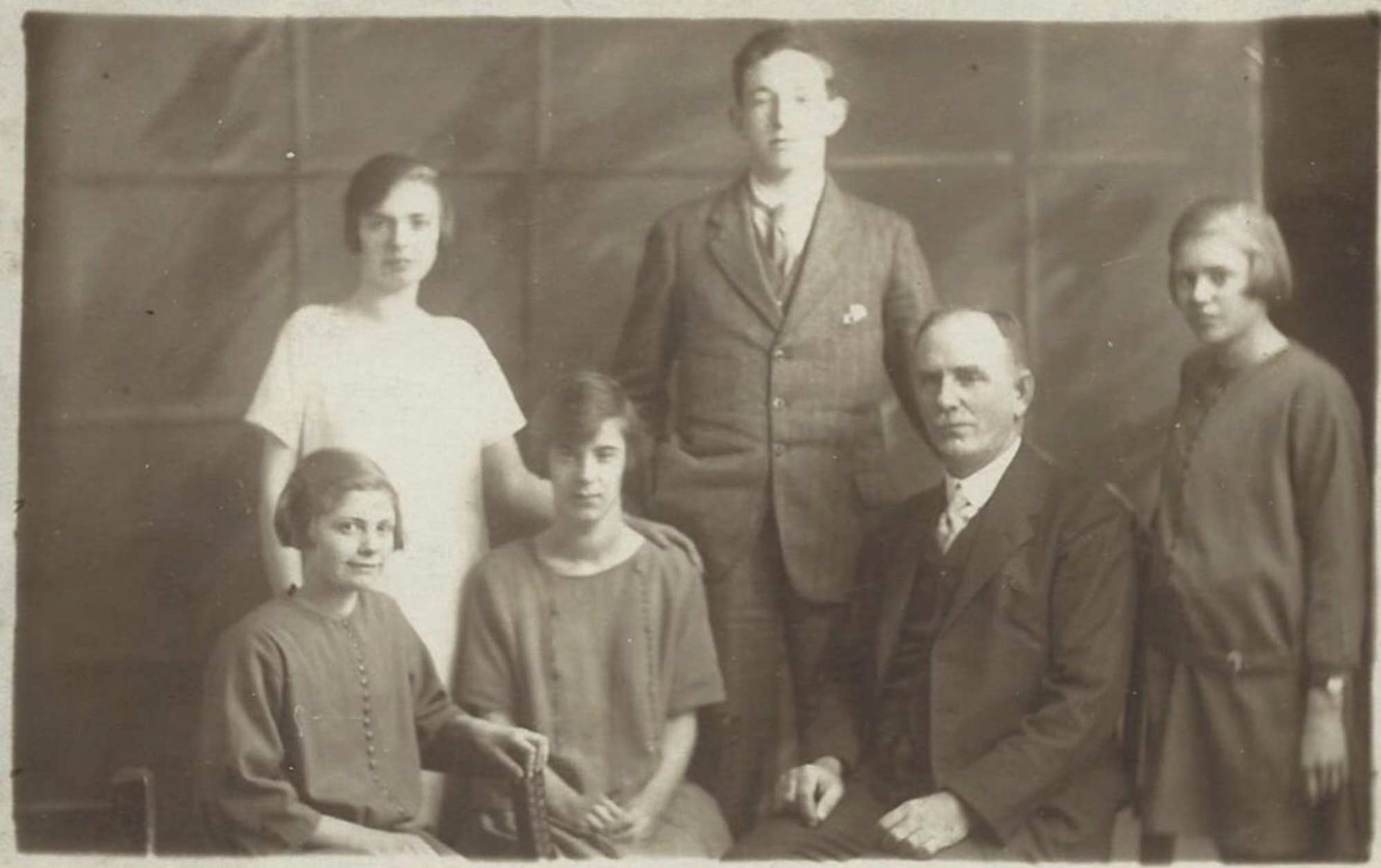
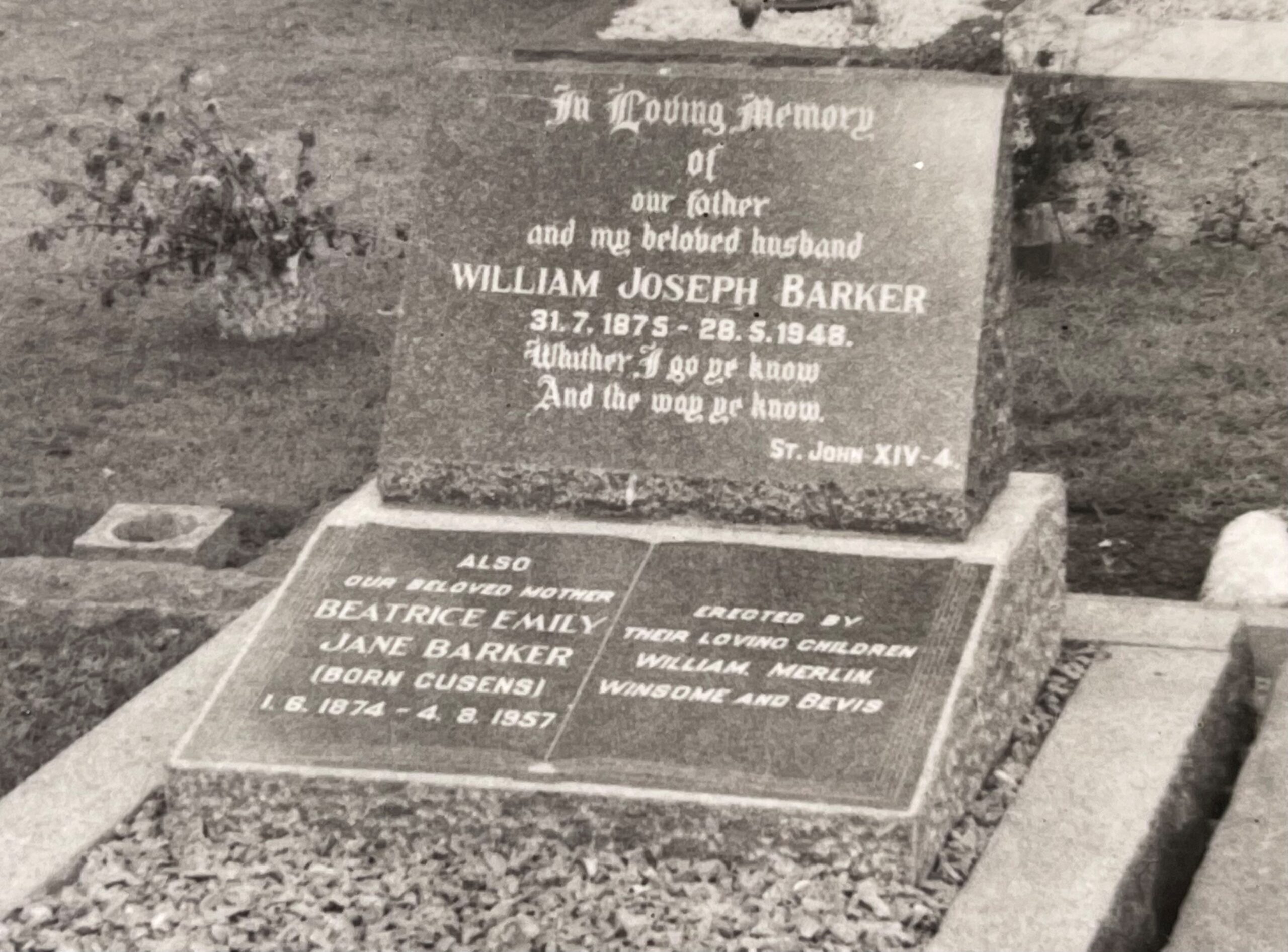
Beatrice Emily Jane (Trissie/ Trixie) (1st June 1874 – the 4th August 1957), was one of 7 children born to **Edward Adolphus Cusens and **Fanny Kingdom Orchard (See **Mary Ann Stears (1820 – 1903) and **George Adolphus Cusens (1819 – 1911)). My mother (Denise Clur nee Barker), told me that her grandmother, Trissie’s special claim to fame was being born in an ox wagon. Edward and Fanny’s children were: Francis Douglas, Claude Edward, Trissie (married Barker), Constance, Fanny Gertrude May (married Anderson), Hazel Gwendoline (married Kemp), Hilda May (married Butt). Constance, unfortunately drowned at the age of about 10 years (Winsome Barker’s family tree).
What my grandfather does not tell in his letter about his father above, is that Alexander James Kidwell was William Joseph’s friend. He called Will “my dearest chum” in a letter dated 23rd March 1900 and signed it “Your old chum“. Alexander Kidwell married Fanny Kingdom Cusens’ sister, Jane Wills Orchard (19.2.1848 – 16.10.1922) in 1867. Alexander Kidwell was the grandson of Alexander Kidwell and Phebe Tubb, both 1820 settlers. Alexander James’ father died when Alexander James was only 14 years old and he was left to fend for himself which he did very successfully. A.J. Kidwell is regarded as the “Father of Jamestown”. Besides being a merchant and Special Justice of the Peace, he was also a Methodist preacher. Some of the old photographs of the Braker family in Jamestown were taken at the K.H. Kidwell studios, Jamestown. In main street Jamestown the sandstone Kidwell Memorial Church can be seen which was named in his memory, as is the adjacent Kidwell Street. Jamestown, Eastern Cape – Wikipedia, Miss Wagenaar’s book) “Jamestown 1874-1974”, 06 | KIDWELL Alexander James, died 1912 and Jane Wills ORCHARD, died 1922, married 1867 Fort Beaufort | The eGGSA Bible Collection | eGGSA.org
Alexander Kidwell and Jane Wills Orchard had 6 children, of whom only three survived to adulthood, Clarice Evelyn, Archibald Alexander and Reginald Hilary (Rex). Clarice married Carl Friedrich Georg von Hirschberg (1862- 3rd October 1934). Carl was born in King William’s Town Amatole, where the German setters settled and near the farm of my great- great-great-grandfather from my father’s side, Johann Michael Clur – 1830-1902. (See also Louise Wilhelmine Flieth – 1845-1928, Carl Georg Puchert – 1834-1914 and Marie Wilhelmine Werbelow – 1833-1923. Carl was the son of Count Franz von Hirschberg (?-c1885) and Countess Adelheid von Lilienstein (12th October 1833-13th June 1912). Carl Friedrich Georg von Hirschberg “Junior” (1926-2017) was the grandson of Carl and Clarice, and son of their son, Francis Arthur (Frank) von Hirschberg. Carl “Junior” was a diplomate and deputy-director-general in the South African foreign affairs department when he wrote the “good” version of the “Rubicon speech” president P.W. Botha was supposed to deliver at the Natal congress of the National Party on the 15th August 1985. Instead of delivering a speech with hope for the abolition of Apartheid and possible freedom of Nelson Mandela, a very different picture was sketched leading to world outrage and extremely detrimental repercussions for the South African currency. When discussing this with my brother Gavin one day, he said, “Yes I know all about the Rubicon speech. I had to do another year in the army because of it!” http://geni.com/people/Carl-Von-Hirschberg/6000000077332922073, https://www.timeslive.co.za/sunday-times/opinion-and-analysis/2017-06-17-obituary-carl-von-hirschberg-writer-of-rubicon-speech-pw-botha-failed-to-deliver/, Geni .com. KIDWELL Alexander James, died 1912 and Jane Wills ORCHARD, died 1922, married 1867 Fort Beaufort | The eGGSA Bible Collection | eGGSA.org
Trissie was in training to be a teacher in King Williams Town when she had to stop to care for her family because her mother Fanny Kingdom Cusens had died young, aged 50, of heart problems on the 7th January 1898. According to her death notice, which was pasted into the Kidwell bible, she died in “the residence of her son-in-law Rev. J.H. Butt of congestion of the brain”. Trissie was an accomplished pianist. She also liked to paint and was a great sewer. Denise Clur nee Barker (1933-), my mother, thinks her picture of Pearson House, Cape Town is very nice. https://en.wikipedia.org/wiki/Kirstenbosch_National_Botanical_Gardens
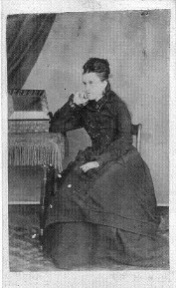
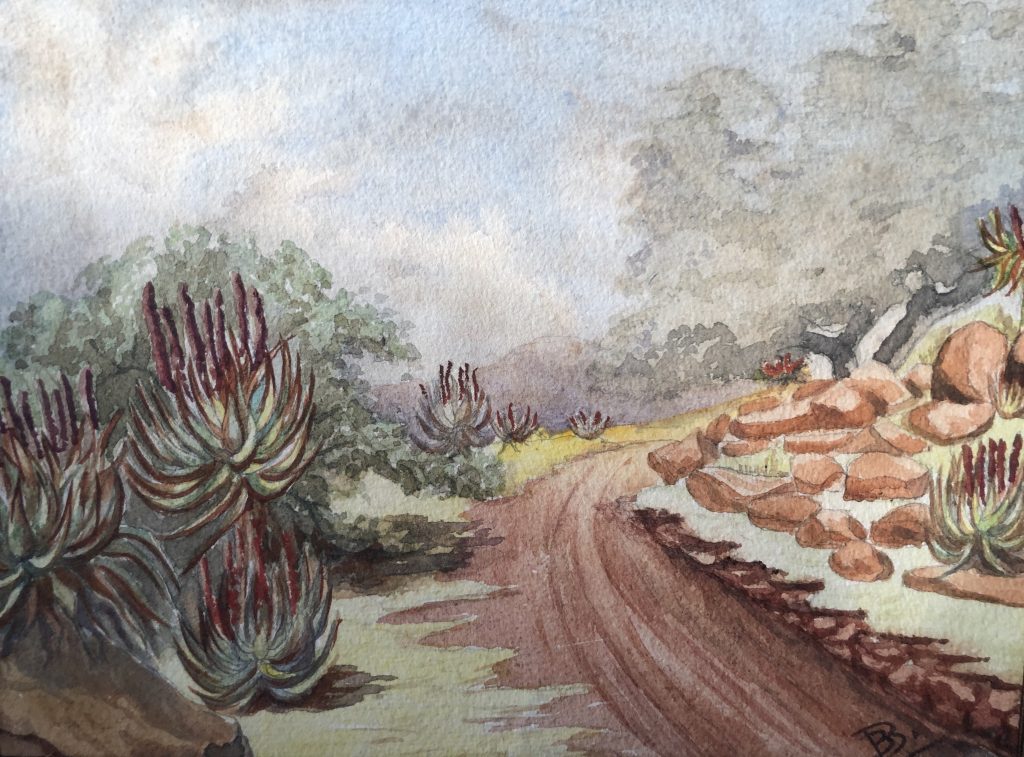
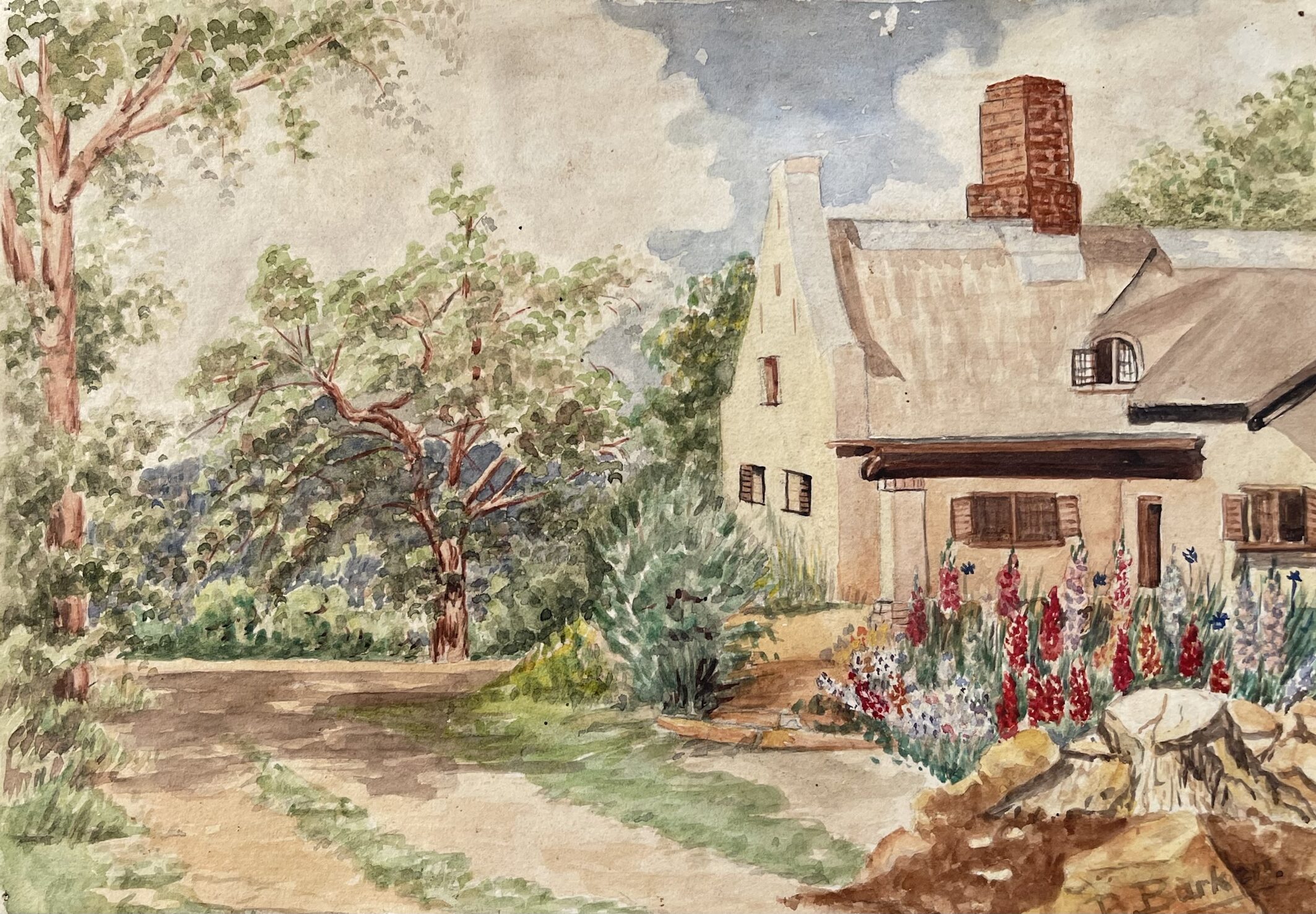
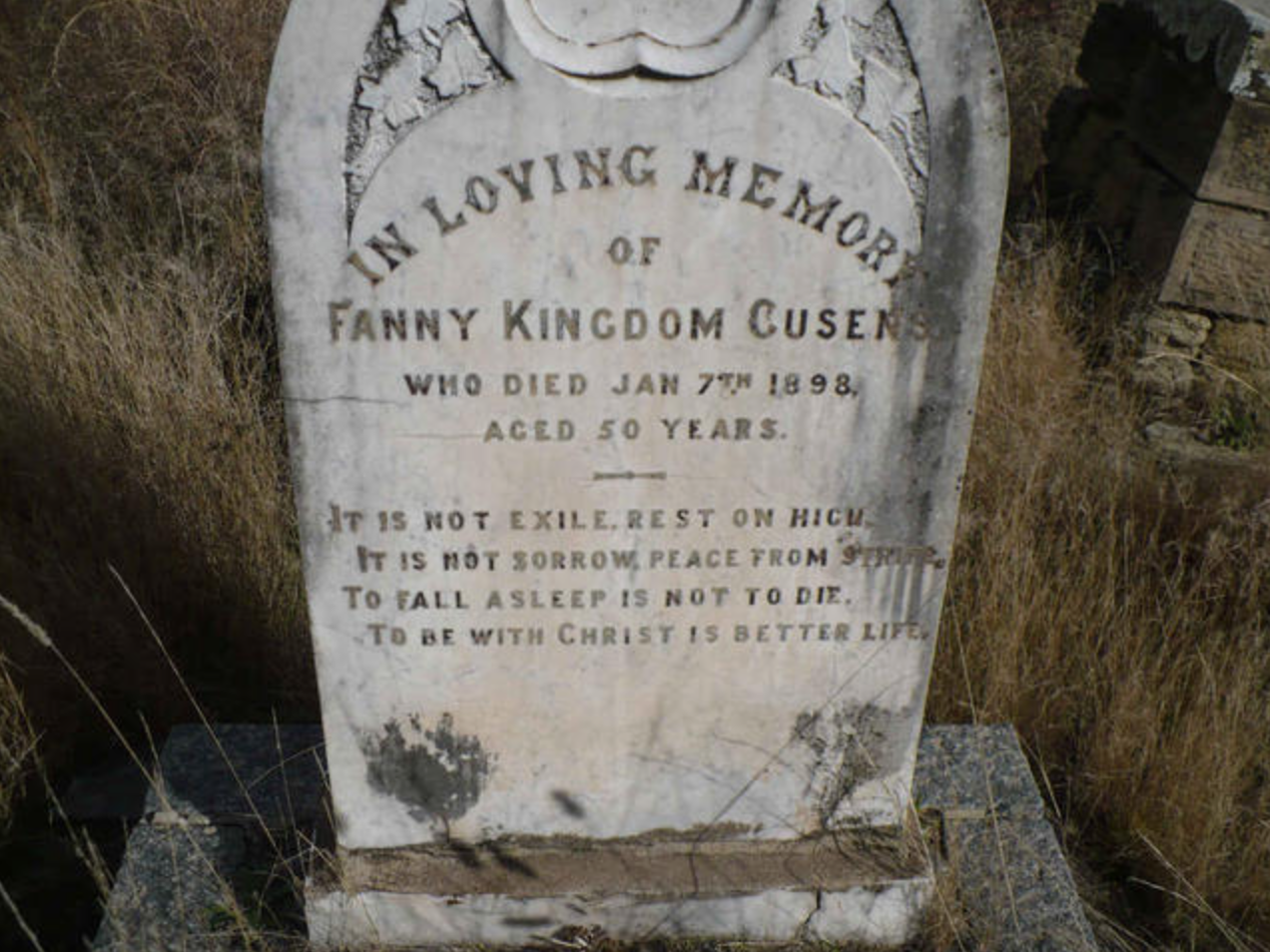
“It is not exile, rest on high
It is not sorrow, peace from strife
To fall asleep is not to die
To be with Christ is better life”

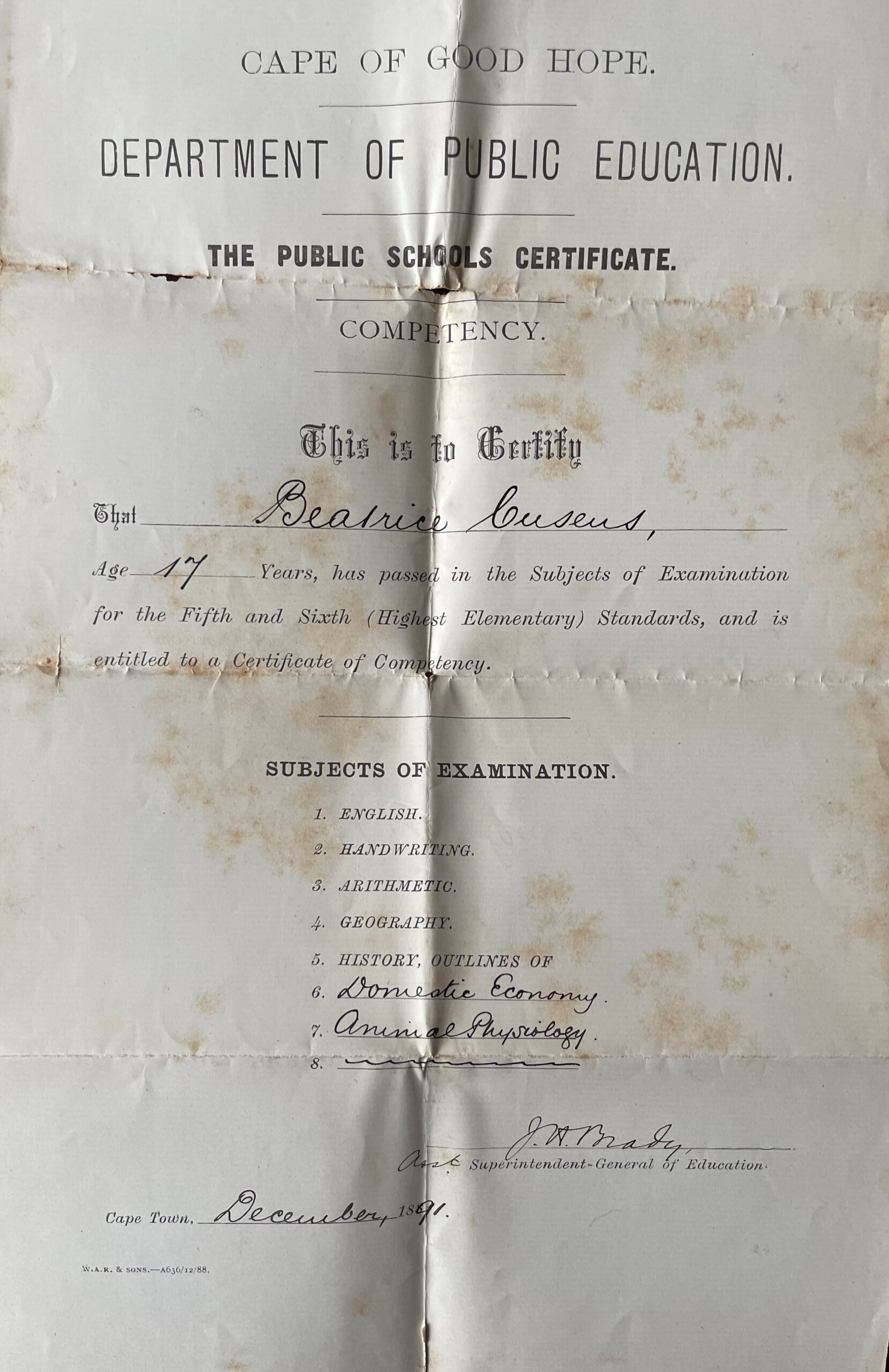
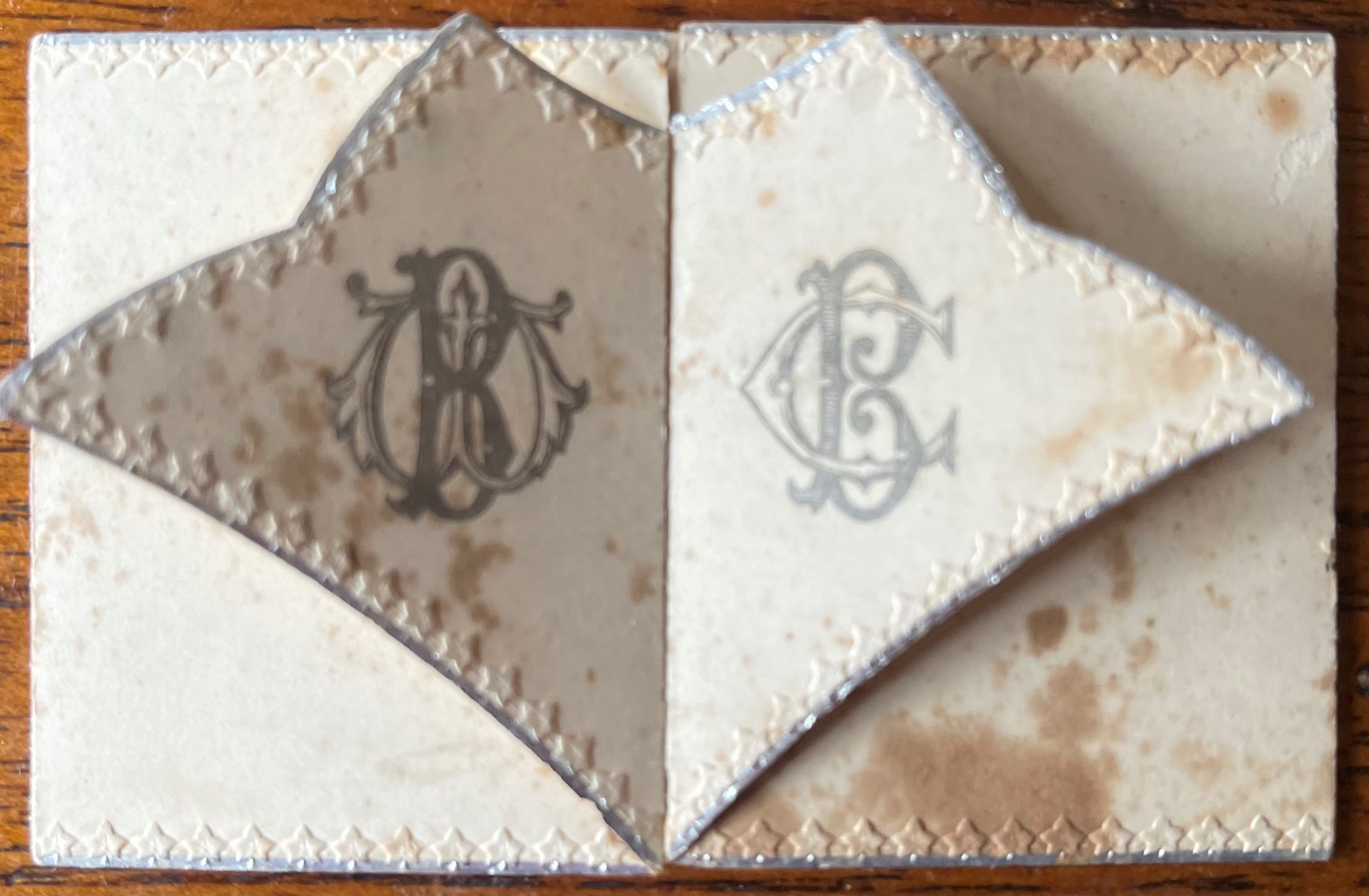

William Joseph and Beatrice Emily Jane married on the 7th April 1903. Exactly a year to the day later my grandfather **William Edward Barker was born. Merlin, their second son, was born two years after that on the 6th of April 1906, so the couple’s wedding anniversary was never forgotten! I always thought it such a pity that Williams Joseph’s letters were burnt after his death by his family in England. Luckily, some of the letters he wrote to Trissie have survived. They tell something of their courtship and personal relationship. The early letters are rather formal, he addresses her very politely as “My dear Miss Cusens” in early 1899, then later as “My own dear Lassie”, “Dearie”, “My own Sweetheart”, “My bonnie Lassie”, “My own little wifey”, “My Way” and “My own dear Way”. She called him “Big Billy Boy” which seems to have appealed to him!
Despite these affectionate communications, there are also rumors of infidelity. While working as an inspector of schools in Transkei he apparently had a relationship with a female colleague. When he refused to leave Trissie to marry her, she apparently threatened to throw herself over the Kei Cuttings.
William and Beatrice had 4 children.
- **William Edward (7.4.1904 -) married **Doris Anne Watkins (19.3.1909 – 9.1.1999)
- Merlin Osmond (6.4.1906 -) married Ann
- Winsome Fanny (23.9.1907- 27.12.1994)
- Bevis Alexander (5.3.1913 -) married Enid Savory
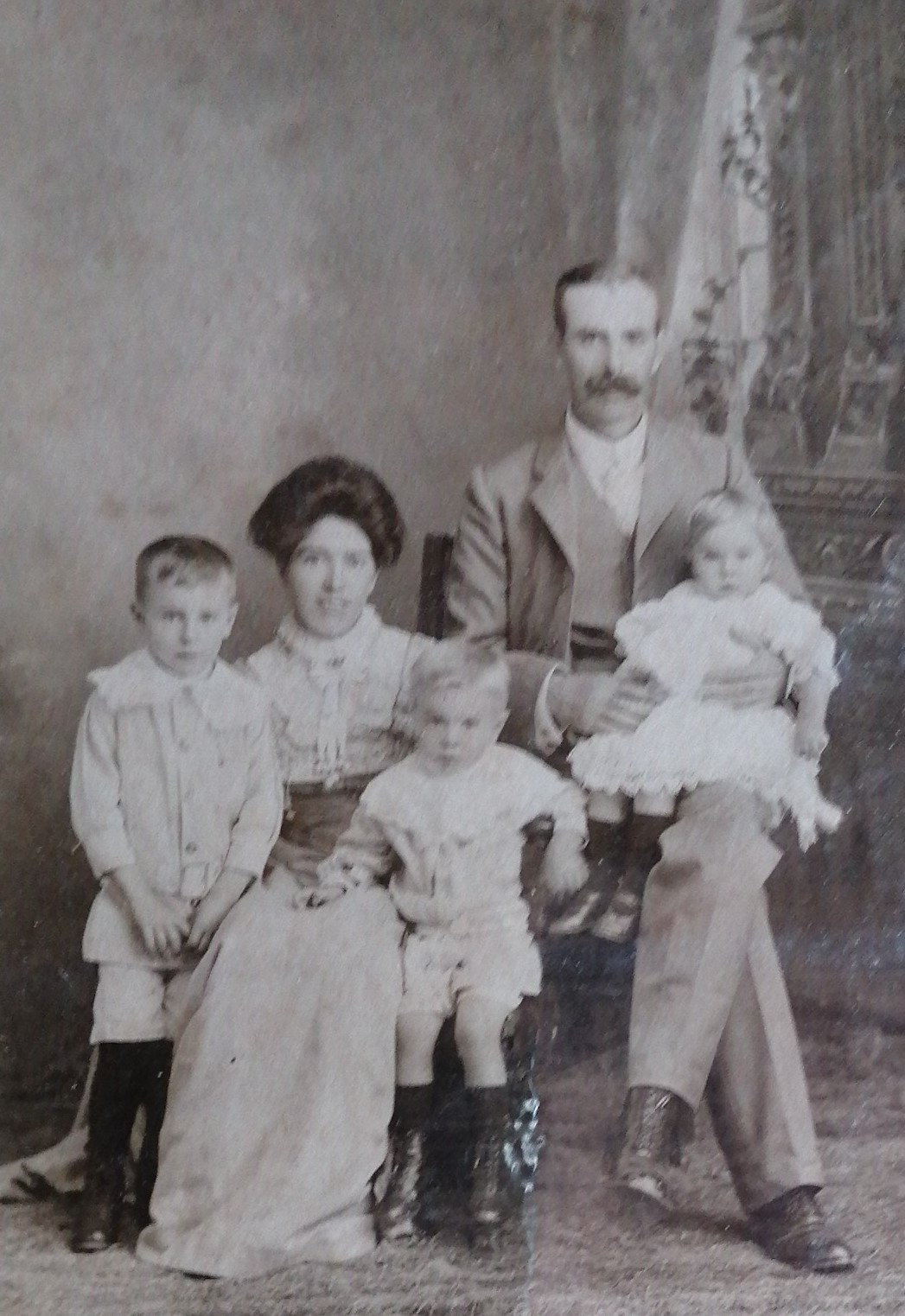
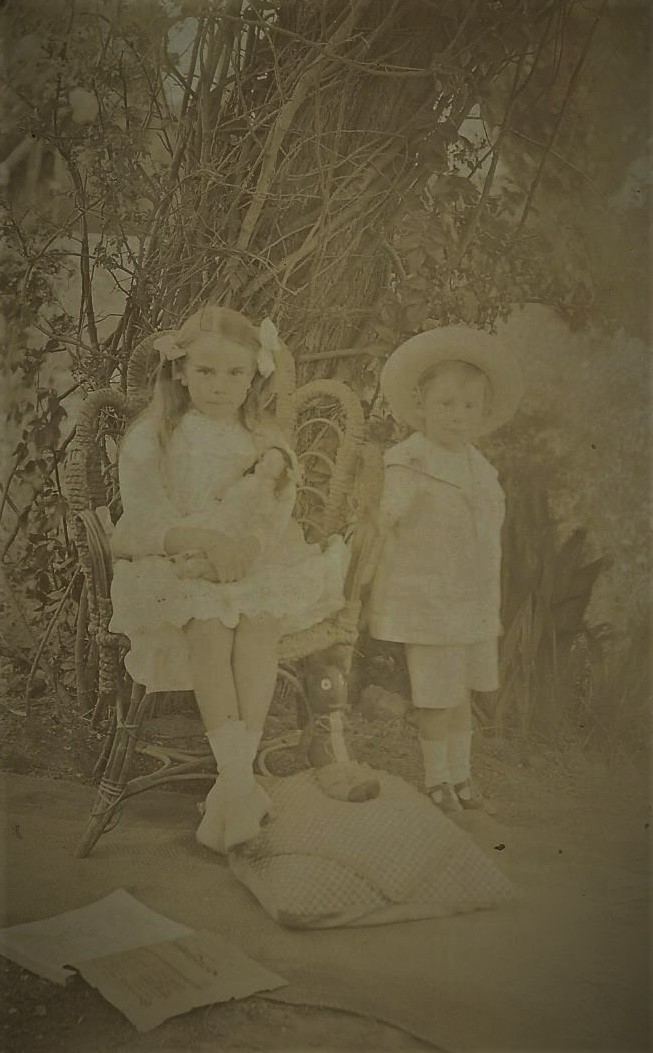
William Edward and Doris Watkins had three children: Denise (9.8.1933 -), Catherine Beatrice (14.11.1935 – 5.2019) and Elizabeth Ann (21.2.1942 -).
Merlin and Ann had two children: Robin Osmond (12.4.1939 -), Lynette Ann (18.12.1937 -).
Bevis and Enid had four children: Hugh Duncan (10.4.1940 -), Dilys Jean 925.9.1943 -), Aileen (25.9.19??-) and Malcolm Bevis (6.3.1954 -)
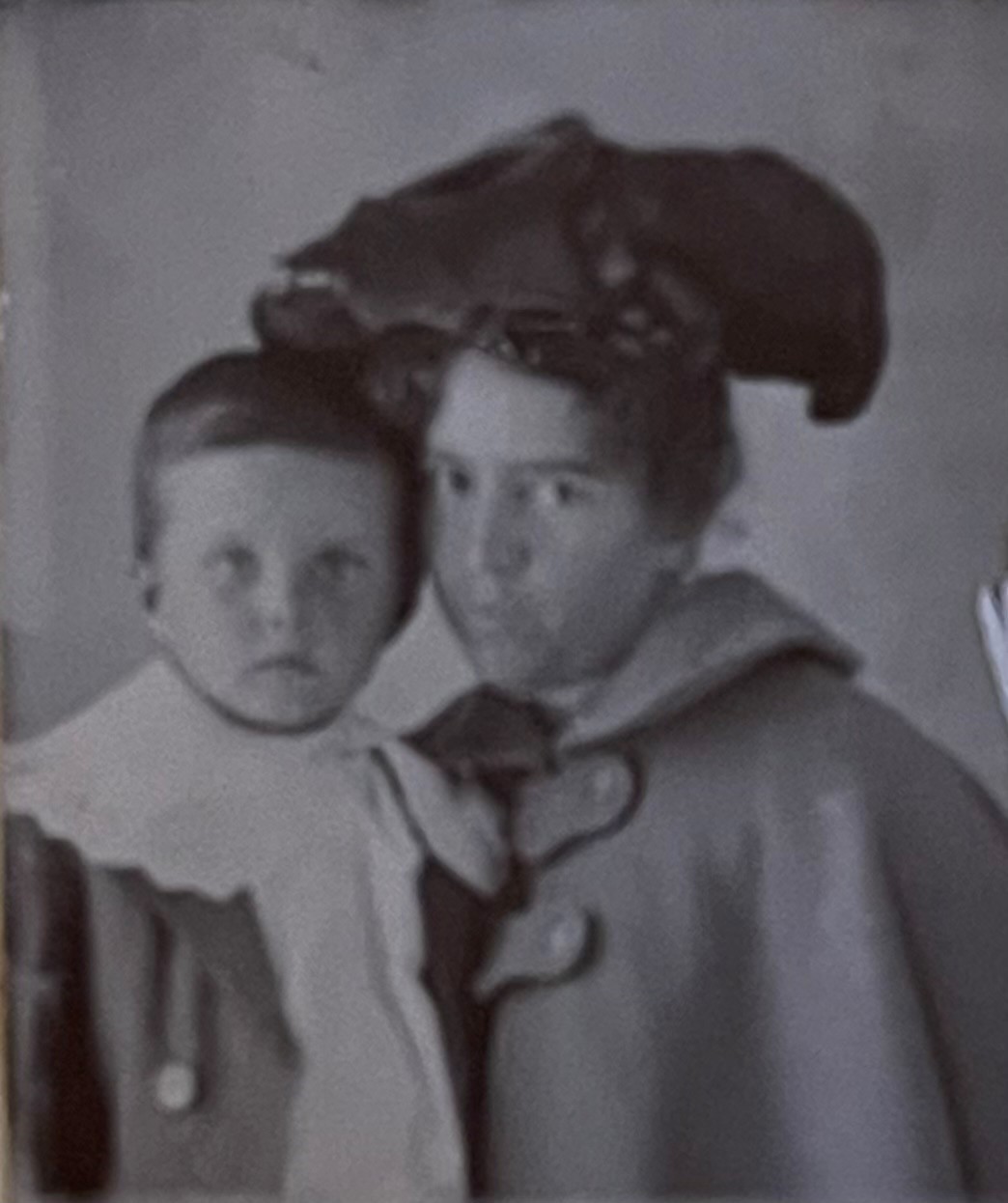
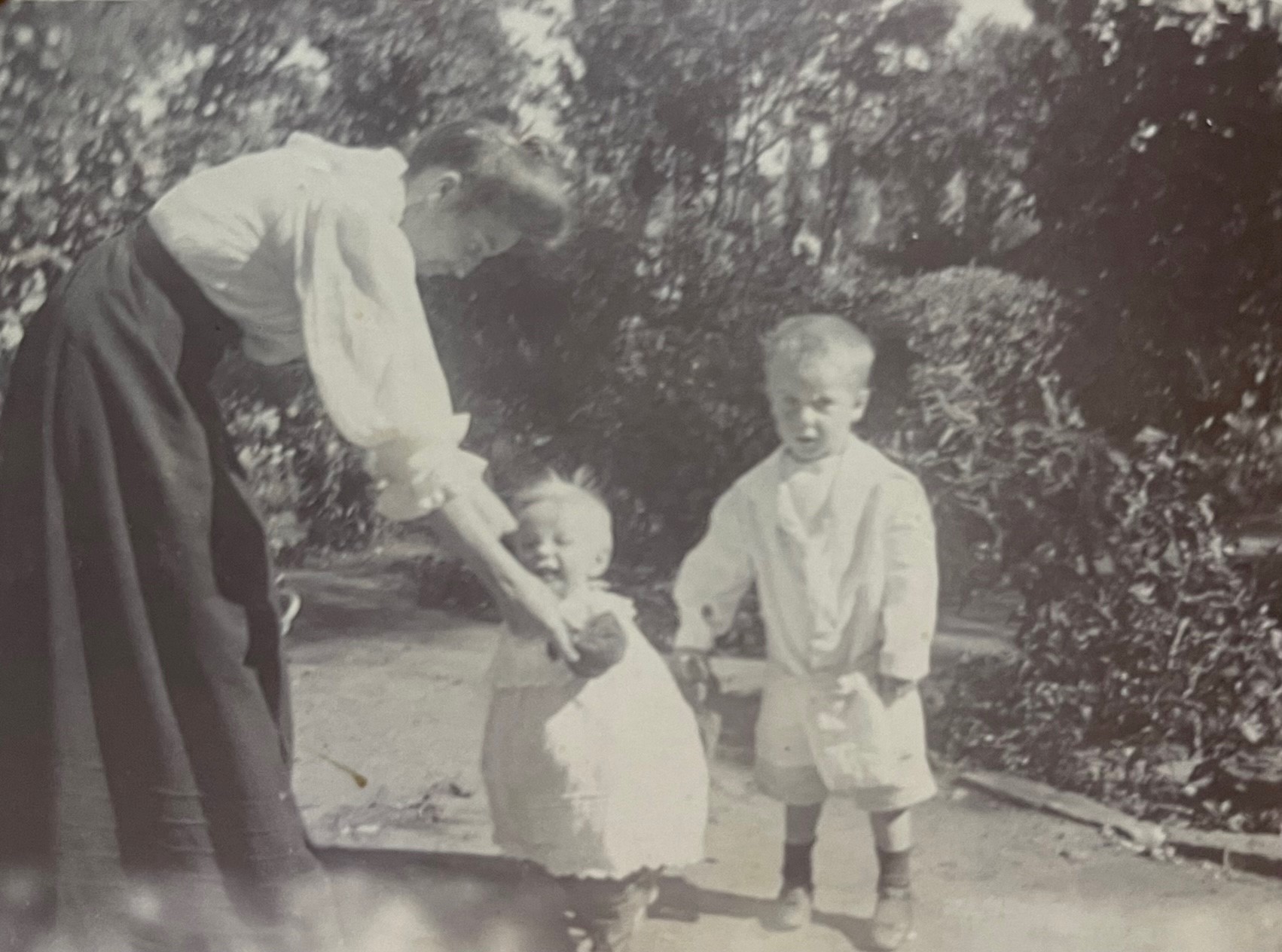
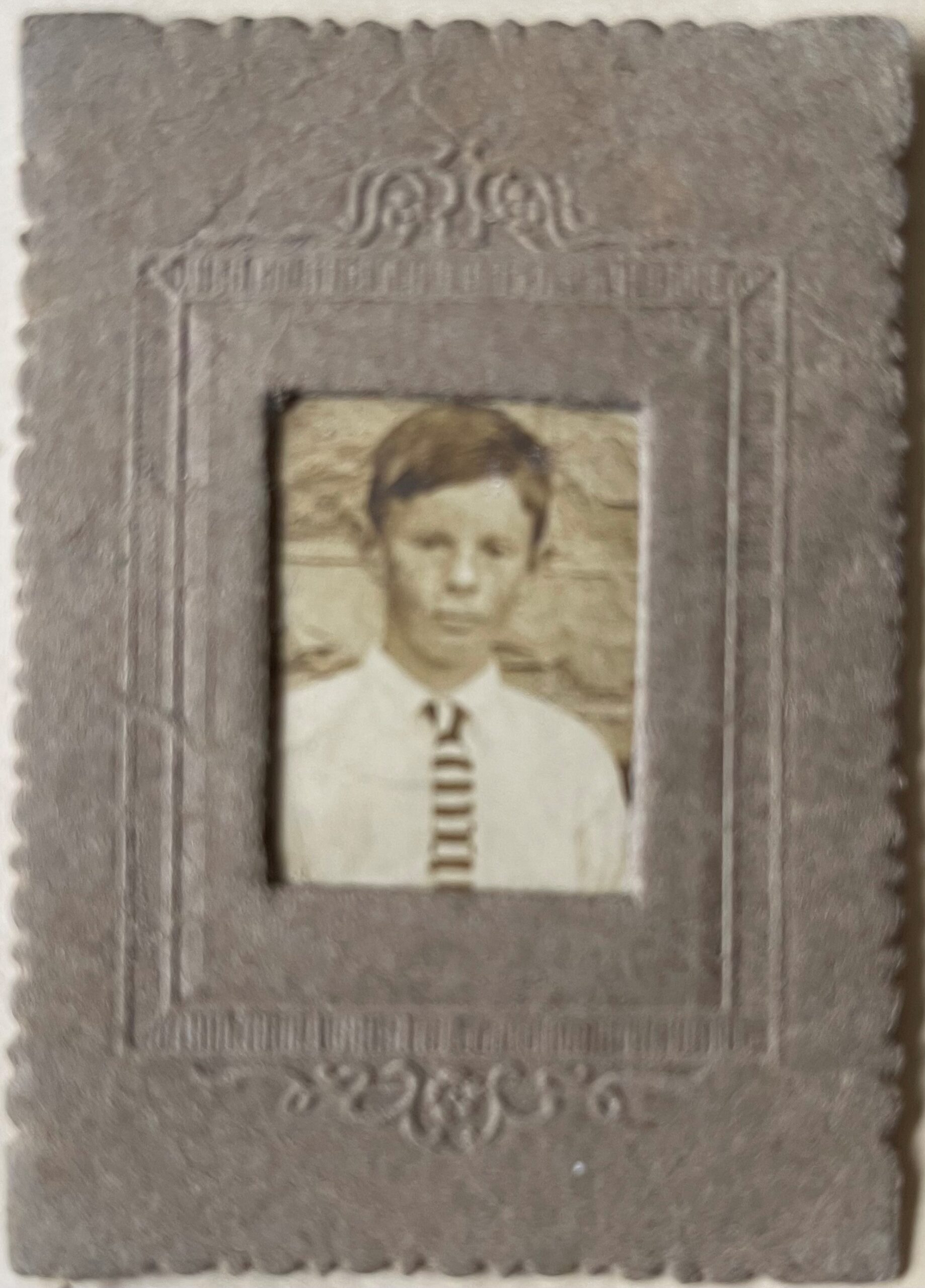
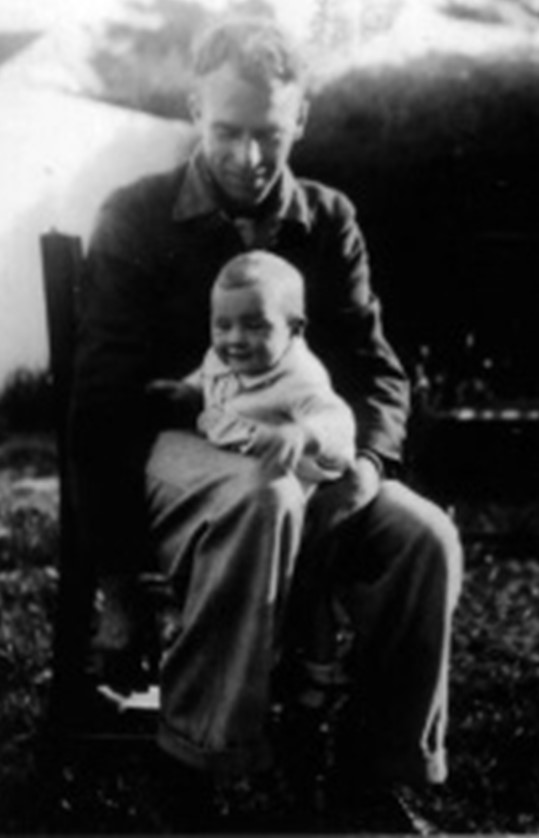




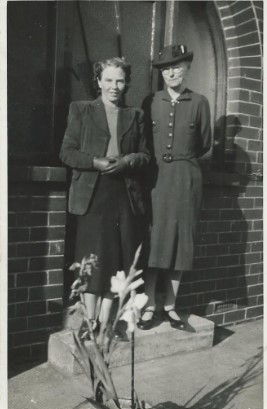
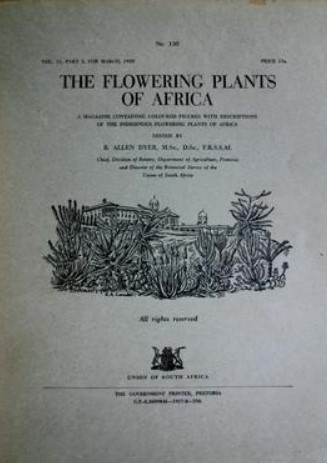

Winsome Barker “Buddy” was the curator of the Kirstenbosch National Botanical Gardens of Cape Town, https://en.wikipedia.org/wiki/Winsome_Fanny_Barker. She visited her cousin Nancie, daughter of Sarah Eleanor McDougall, nee Barker several times in the UK. This included a visit just before the outbreak of WWII. She was so keen to get back to Kirstenbosch, for work related reasons, that she opted to go back in an unescourted convoy to Cape Town, despite the considerable risks involved.
Win, as we called her, was an accomplished botanical illustrator and published illustrations in Flowering Plants of South Africa between 1930 and 1938, and Agapanthus watercolours in the Royal Horticultural Society in London. Between 1930 and 1950 she painted 107 colour images of Lachenalia for the Compton Herbarium at Kirstenbosch. Lachenalias were her favourite plants and between 1930 and 1989 she described 47 new species and 11 new varieties. Although always her ambition to publish her monograph on Lachenalias, she died on the 27th December 1994 (at the age of 87) without achieving her goal. The subsequent Curator of Kirstenbosch, Graham Duncan, who was influenced and inspired by her, went on to complete the work, and in 2021 the book, “The Genus Lachenalia“, was finally published.

